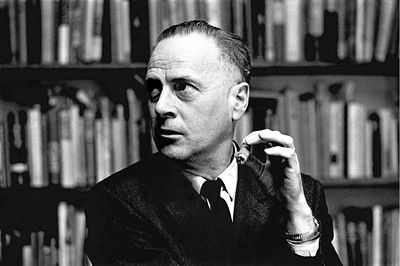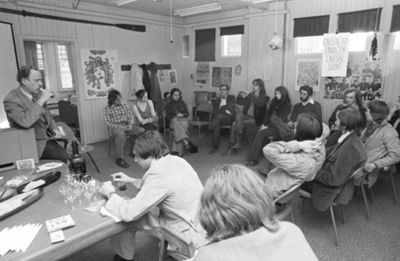Marshall McLuhan
From DigitalRhetoricCollaborative
| Line 66: | Line 66: | ||
McLuhan married Corinne Keller Lewis in 1939. They have two sons and four daughters: Eric, Mary, Theresa, Stephanie, Elizabeth, and Michael. <ref> http://www.nndb.com/people/869/000047728/ </ref> | McLuhan married Corinne Keller Lewis in 1939. They have two sons and four daughters: Eric, Mary, Theresa, Stephanie, Elizabeth, and Michael. <ref> http://www.nndb.com/people/869/000047728/ </ref> | ||
| - | + | =References= | |
<references/> | <references/> | ||
| - | + | =External Links= | |
1. http://www.marshallmcluhan.com/ <br/> | 1. http://www.marshallmcluhan.com/ <br/> | ||
2. http://en.wikipedia.org/wiki/The_medium_is_the_message <br/> | 2. http://en.wikipedia.org/wiki/The_medium_is_the_message <br/> | ||
Revision as of 05:29, 23 April 2015

Born: Edmonton, Alberta, Canada
July 21, 1911
Death: Toronto, Ontario, Canada
December 31, 1980 [1]
Contents |
Marshall McLuhan[1] was a Canadian philosopher and father to the study of the digital media generation. He is considered one of the most influential and controversial intellectuals in the new wave of academic and technological understanding. He noted that the differences in human perspectives are not solely judged upon ideas, but that technology plays a vital role as well."The medium is the message" [2] is the most notorious phrase created by McLuhan to summarize his ideals on the role of a message and its relationship with the choice of medium. McLuhan stressed the importance in knowing the purpose behind a message and appropriately delivering it. He wanted to know the HOW aspects more than the WHAT ideas about a medium's structure.
Although McLuhan sparked new theories and continues to fuel debates across the scientific platform, he is not remembered for speaking often. Therefore, websites have collected unpublished works, past theses, and even recordings of McLuhan saying his infamous quotes and sayings.[2] McLuhan plays a prominent role in the formation and development of digital media, which has now burgeoned into a entirely separate topic itself. He created a platform for media thinking and advanced the 20th century into a new dimension of thought.
Background
Education
Marshall graduated with a B.A. from the University of Maitobe in 1932 and a M.A. in 1934. He then continued his graduate studies at the University of Cambridge, receiving his Ph.D. in Literature in 1942.
Career
Marshall's first teaching position was at the University of Wisconsin, Madison from 1936-1937. After a year, he taught at St. Louis University from 1937-1944. He accepted a position at Assumption University from 1944-1946. Marshall became an official professor in 1952 amidst his time teaching at St. Michael's College, University of Toronto from 1946-1979.
<right>===Centre for Culture and Technology===</right>

The program first opened in 1963 as ain order to provide a setting for further research and development.
McLuhan and his oldest son, Eric McLuhan, worked together on a project to create a construction of his ideas.
The ideas were organized and grouped into the "4 Laws of Media" 4 Laws of Media:
every technology
- 1) enhances part of our culture
- 2) previous obsolesces aspects enhanced
- 3) retrieves elements previously obsolesced
- 4) eventually reverses or "flips" into something else when pushed to the extreme[4]
The current program continues to operate at the University of Toronto. The goal of the institute is to facilitate knowledge about technological effects on culture and society from a "theoretical and practical" [5] perspective.
Published Works
- The Mechanical Bride: Folklore of Industrial Man (1951) [3]
- The Gutenberg Galaxy: The Making of Topographic Man (1962) [4]
- Understanding Media: The Extensions of Man (1964) [5]
- The Medium is the Massage: An Inventory of Effects (1967) [6]
- War and Peace in the Global Village (1968) [7]
- Culture is Our Business (1970) [8]
- From Cliché to Archetype (1970) [9]
Awards
Albert Schweitzer Chair in the Humanities at Fordham University (1967-68) Molson Award for Outstanding Achievement in the Social Sciences (1967) Companion of the Order of Canada (1970) Gold Medal Award from President of the Italian Republic (in recognition of original work as philosopher of the mass media, 1971) Vatican appointment as Consultor of the Pontifical Commission for Social Communications (1973)
Personal Life
McLuhan married Corinne Keller Lewis in 1939. They have two sons and four daughters: Eric, Mary, Theresa, Stephanie, Elizabeth, and Michael. [6]
References
- ↑ https://verbooom.wordpress.com/2012/12/11/understanding-the-philosophy-of-marshall-mcluhan/
- ↑ http://marshallmcluhanspeaks.com/
- ↑ http://heritage.utoronto.ca/fedora/repository/default%3A9313
- ↑ http://www.nndb.com/people/869/000047728/
- ↑ http://mcluhan.ischool.utoronto.ca/
- ↑ http://www.nndb.com/people/869/000047728/
External Links
1. http://www.marshallmcluhan.com/
2. http://en.wikipedia.org/wiki/The_medium_is_the_message
3. http://www.marshallmcluhan.com/biography/
4. http://en.wikipedia.org/wiki/The_Mechanical_Bride:_Folklore_of_Industrial_Man
5. http://en.wikipedia.org/wiki/The_Gutenberg_Galaxy
6. http://en.wikipedia.org/wiki/Understanding_Media
7. http://en.wikipedia.org/wiki/The_Medium_Is_the_Massage
8. http://en.wikipedia.org/wiki/War_and_Peace_in_the_Global_Village
9. http://www.amazon.com/Culture-Our-Business-Marshall-McLuhan/dp/1625648286
10. http://en.wikipedia.org/wiki/From_Clich%C3%A9_to_Archetype
